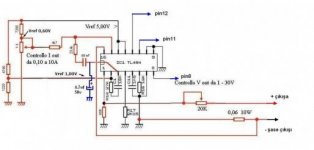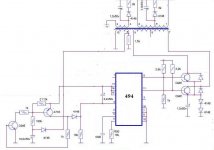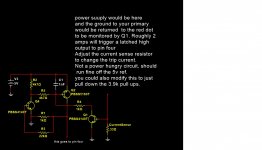You are using an out of date browser. It may not display this or other websites correctly.
You should upgrade or use an alternative browser.
You should upgrade or use an alternative browser.
How does this overpower/short circuit protection circuit works?
- Thread starter delta67
- Start date
Yes, the goal is to pull pin 4 up. But how ?.... lifting pin 4 above maximum dtc voltage?
What is the roles of diode and capacitor in the base of a733?
When there's a short circuit the voltage at the capacitor increases or decreases?
Why we don't invert the diode and connect it's cathode to the base of the npn transistor c945?
Silvio
Well-known member
Maybe you can opt for a current transformer in the center of the half bridge, Then feed the rectified output of the current trafo to control the pulse width via the soft start pin. This will become a current fold back control. One other option is to use the over current opamp on the TL494 to control the output current via a sense resistor on the output. I do not see any particular reason why not using it. What about output voltage regulation using pin 1 and 2? What kind of PSU are you making after all?
1- you can opt for a current transformer
2- use the over current opamp on the TL494
3- What kind of PSU are you making after all?
1- I want the simplest solution.
2- you mean pins 15 and 16?
3- I'm moding a PC ATX PS to get regulated voltage using pins 1 and 2 and constant current using pins 15 and 16 and a sense resistor.
Because of the constant current option we don't need a short circuit protection, but I want to add this function in case of a short in the sense resistor, who knows !
How to check if the short circuit protection is working without burning the power supply?
Silvio
Well-known member
Follow this circuit it works I tried it you will have variable voltage and variable current. You can make fixed resistors instead of pots if you do not want it variable. Just omit the 4.7uf cap tied to pin 3

you can also follow this link http://320volt.com/en/akim-voltaj-ayarli-atx-smps-guc-kaynagi-modifiye/

you can also follow this link http://320volt.com/en/akim-voltaj-ayarli-atx-smps-guc-kaynagi-modifiye/
Last edited:
Follow this circuit it works I tried it you will have variable voltage and variable current. You can make fixed resistors instead of pots if you do not want it variable. Just omit the 4.7uf cap tied to pin 3
View attachment 6268
you can also follow this link http://320volt.com/en/akim-voltaj-ayarli-atx-smps-guc-kaynagi-modifiye/
You could build a simple latch and monitor the current on the primary ground return(s)
any transistors should work, although some tweaking maybe required.
View attachment 6269
OK thanks a lot for the link and the circuits.
I've already do the mods as shown in 320V circuit and it works, but if I fix the current for a given load and change to other one the current change a little !!
Silvio
Well-known member
Your lowest current adjustment will be 100mA or 0.1 amp you cannot go to zero
Well 100ma that variation is nothing compared to the full range. You must have a 10watt resistor of 0.06 ohms otherwise you can opt for 2 X 0.1 ohm by 5watt resistors in parallel but this gives a different value and the range will step up to say 12 or 13 amp. To cure that you must change the resistors for the 0.6v reference and make them to get 0.5v reference instead. Do not forget that the lower the value of the sense resistor the resolution for the current sense will worsen. If for example you opt for a 0.1 ohm then your reference has to be 1v. This will give better resolution and current sense will be more accurate. Yet again you then have more dissipation in the sense resistor and because of that you have to make a larger wattage resistor.
The wattage in the resistor is calculated by ohms law hence 10 amps X 0.06 ohms = 0.6volts then power of resistor will be 0.6volts X 10amps which will give a power of 6 watts hence a 10watt resistor will be suitable.
If for example we opt for 1volt reference and a sense resistor of 0,1 ohm is chosen then the power dissipation in the resistor will be 1v X 10 amps =10 watts yet again a 20 watt resistor must be chosen other wise it will heat up and change value.
A compromise have to be set according to your need either the lower value but not so accurate or the higher value will be more accurate but need a larger watt sense resistor.
One last comment I suggest you use a 10 turn pot for adjustment of voltage and current
Hope that helps
Well 100ma that variation is nothing compared to the full range. You must have a 10watt resistor of 0.06 ohms otherwise you can opt for 2 X 0.1 ohm by 5watt resistors in parallel but this gives a different value and the range will step up to say 12 or 13 amp. To cure that you must change the resistors for the 0.6v reference and make them to get 0.5v reference instead. Do not forget that the lower the value of the sense resistor the resolution for the current sense will worsen. If for example you opt for a 0.1 ohm then your reference has to be 1v. This will give better resolution and current sense will be more accurate. Yet again you then have more dissipation in the sense resistor and because of that you have to make a larger wattage resistor.
The wattage in the resistor is calculated by ohms law hence 10 amps X 0.06 ohms = 0.6volts then power of resistor will be 0.6volts X 10amps which will give a power of 6 watts hence a 10watt resistor will be suitable.
If for example we opt for 1volt reference and a sense resistor of 0,1 ohm is chosen then the power dissipation in the resistor will be 1v X 10 amps =10 watts yet again a 20 watt resistor must be chosen other wise it will heat up and change value.
A compromise have to be set according to your need either the lower value but not so accurate or the higher value will be more accurate but need a larger watt sense resistor.
One last comment I suggest you use a 10 turn pot for adjustment of voltage and current
Hope that helps
Last edited:


